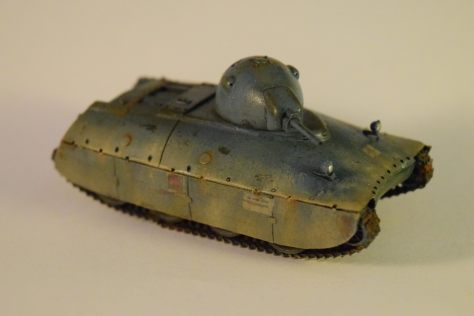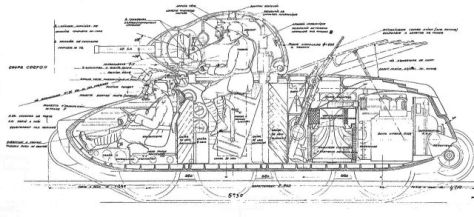
I have written a review of this kit for Armorama; most of the introduction is reused for this post. Should you wish to see one moving, check this link out.
There are three 1/35 kits available for this tank, all of which were issued in recent years -so officially there are more models than actual vehicles in existence. (Something only the Tiger I has achieved to this day.*) Before the styrene versions came out almost at the same time (which makes me wonder how companies decide on what to work on next and why they always seem to decide on the same vehicle**), there was a 1/72 resin version by OKB of this extraordinary-looking tank. Frankly, it looks like the tracks were only an afterthought; you’d expect to find anti-gravity propulsion installed. (Perhaps the subcontractors were late with that project.)
*~ducks~
**these days we can all anticipate the incoming new King Tiger kits with full interiors… it’s an interesting choice to flood the market with something that someone already is producing instead of coming out with something new. This enigma, along with the tendency of Hollywood to do the same thing with movies, will always perplex me.
The tank was designed in the Kirov Plant in 1957 to resist HEAT ammunition and have good off-road capabilities (the ground pressure was less than 0.6 kg/cm2). The weird shape would also ensure that the maintenance would be a nightmare for the crew -especially if the tank threw a track. Surprisingly it was able to reach 55km/h, and had a range of 300km, which is pretty good for a heavy tank- even more so for one with four sets of tracks. (Decreased air resistance due to the shape of the hull might have something to do with this…)
The shape of this tank was due to a second layer of shielding which covered the hull. It served multiple purposes. First of all it was supposed to make it harder to flip the tank over (nuclear blasts do tend to have some strong shockwaves). It also worked as a protection against HEAT and APDS projectiles, and against shaped charges. (I really would like to crawl into the prototype displayed in Kubnika to see what the interior looks like.) The tank was obviously equipped with CBRN protection. The main armament was a rifled, 130mm gun (M-65) with 24 rounds of ammunition, the secondary armament was a KPVT coaxial machine gun; they were stabilized in two planes.
The history of the tank was not very illustrious. Once the prototype completed all its trials (which showed a couple of problems with the track system), the program was axed by Khrushchev himself, as it was way too heavy for the requirements set for new tanks. (In short, the Soviet leadership viewed heavy tanks as outdated, and were obviously blind to the propaganda value of a weapon created apparently using alien technology.)
It took me some serious deliberation to purchase the Braille scale version of this model by OKB as it costs about the same (or more in some cases) as the 1/35 versions. In the end I’ve decided to go with it as I prefer this scale in case for large vehicles. I have a constant space shortage at home, which is the main reason my 1/144 Dora stays in her box for now.
Interestingly as I was progressing with the build, Wargaming just came out with a video on the tank itself.
The model comes in a small, sturdy cardboard box. The box art is a photo of the vehicle displayed at Kubnika; however it was seriously faded in my kit. In it we find several small Ziploc bags, and some pieces of bubble wrap which make sure that the kit arrives unharmed and undamaged.
The instructions –which are a rare thing indeed in resin model circles- are clear and computer generated. The only problem is that it’s difficult to see the images as they were pretty faded. (OKB will email you a set of instructions if you ask them ASAP, so this is not an issue.) Since the model is relatively simple, even using the faded instructions does not impact on the assembly process.
The model is made up by about 70 resin pieces and 30 PE parts. The parts are very well detailed, the flash is minimal, and the fit is excellent. One of the swing arms of the suspension was miscast, but generally the quality of resin is excellent.
The tracks are given as sets of straight resin pieces, which need to be warmed up before being shaped to fit the running gear. (I prefer hot –not too hot- water to a hair dryer for this job. Hairdryers can be surprisingly hot, and damage the resin.) The hull comes in one piece; most of the small parts make up the running gear. The muzzle break on the gun is something to be seen: it’s quite a complex shape with several openings and it’s moulded in one piece; A pretty impressive affair. The photoetched fret is very thin and very delicate; it’s very easy to bend (even crumple) the parts, which makes working with them a bit difficult.
Putting the running gear together was not very difficult; the swing arms fit into their slots remarkably well. (The small wobbling unfortunately will show when you attach the wheels, as they will be somewhat misaligned. When the suspension units are done, it’s best to use some hot water to warm the whole thing up, align everything between two rulers, and wait for the resin to cool down.
I would have preferred to put the tracks on while the assembly was off the hull but the drive wheels are separate units. This means you’ll need to glue both the running gear and the drive wheels onto the bottom of the hull first, then add the tracks. To make your life easier you can add the front section of the tracks on the suspension while they are off the hull.
Now, there was a little issue at this point: one of the sections holding the running gear did not fit into the groove on the lower hull. After a little fiddling I found the reason: it was a couple of millimeters longer than the other. Some trimming had to be done to make it fit. Another issue I’ve already mentioned: one of the suspension arms had a casting error, so it was too short to add a wheel. I made sure this section was turned inwards so it would not be seen.
The face of the drive wheels is made out of PE. As I said the PE bends very easily, so assembly was not exactly easy. (They bend readily even to the small pressure needed to push them in place.) Since the resin axles were a bit thicker than the holes in the PE parts I needed to trim them a bit using a knife. I used epoxy glue for most of these parts, since I wanted to make sure they will hold strong; this is important especially when you install the tracks.
Once the drive wheels and the whole running gear was on the tank, I added the tracks. (Warm them up, wrap them around the running gear, wait.) There are some tight fits between the running gear and the bottom of the hull, but all four sections went on eventually.
The hull is not a difficult affair to assemble: you need to add the towing hooks, the PE tiedowns for the external fuel tanks on the back, and the PE handholds. These handholds were a bit problematic: you need to fold the legs down, but there is no marking where to fold; these markings usually make it easier to fold the part in a neat right angle. Use a plyer or a hold-and-fold. The metal is very thin, so it is extremely easy to distort its shape while working with it.
The travel lock is made out of PE (not sure if you can make it functional; the gun barrel is made out of several pieces, so technically it should be possible.) The headlights and the guards for the headlights are pretty easy to install. I noticed that the metal strips for the guards are somewhat longer than necessary, so I trimmed them, and made a little fold at the ends so they stick better to the hull. The exhaust has a rectangular metallic guard around it.
The gun barrel made out of several sections, and it’s kind of hard to make all the pieces align perfectly straight. The muzzle break, as I said, looks really great.
The turret is also a simple affair There are two PE squares on the top (I think this is where they are supposed to be- it was hard to see on the instructions and the photos were not very good for that angle). The IR headlight is fixed next to the gun, I’ve prepared a couple of handholds using wire, and attached the gun barrel; that’s it. (Obviously I only primed the tank so far; it will be finished after the Christmas holiday.)
Once I had the rust-brown base coat on, I’ve sprayed some Tamiya Nato green lightened with tan, and mixed with some AK Washable agent as a test. The test was a partial success – some vigorous brushing did manage to remove some of the paint. Clearly more experiments are needed with different paint/agent ratio. Once the paint was dry I fixed everything with some varnish and added some decals from the leftovers. The decals were fixed with some Dullcote.
I proceeded to add oil washes, and some light ochre filters, and went on to see how I can make the tank look dirtied up without overdoing the effect.
I picked up some Tamiya weathering sticks in HobbyCraft at their latest sale, so that was the first stop. It’s a strange, almost lipstick like product (pen shaped), and direct application only deposits some non-realistic smears. Using a stiff brush to add the paste and adjusting the pattern after application with a wet brush seemed to work well, though. I used the mud version to add mud on the lower chassis and the running gear, along with the edges of the top of the tank; and I used dust to add deposited dust/dry mud onto the top. With downwards stokes I tried create a perpendicular pattern to the edges as if they were marks made by the water pouring/tickling down from the hull. I repeated the process on the turret as well although much more subtly.
Since it did not look enough (only two colors do not look very convincing) I’ve mixed up some darkish (almost black) brown mixture of pigments and matte varnish, and flicked it onto the hull with a brush and toothpick to simulate fresh mud splashes.
I’ve used some weathering effects (oil stains and diesel stains) on the running gear and the external fuel tanks, respectively), and called the tank finished.
The build was not a challenging one; in fact it was easier to build than most resin models I’ve built so far. This is the third OKB model I’ve built, and I have to say they are very well engineered models: clear instructions, good detail, and no major issues to remedy. The only real drawback is the price- for most people this would make the 1/35 offerings more attractive.


































































































